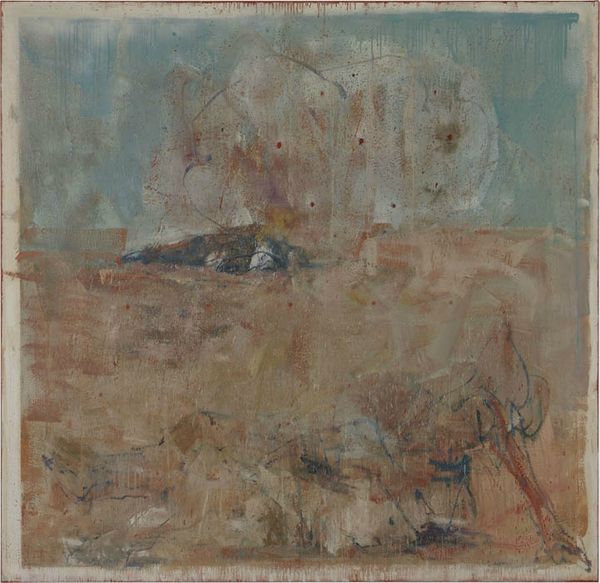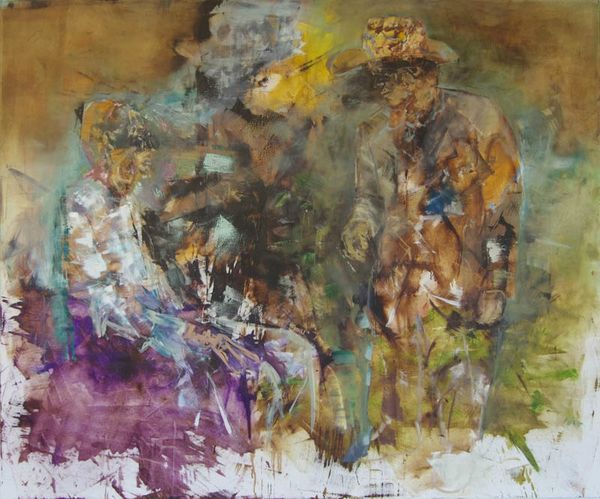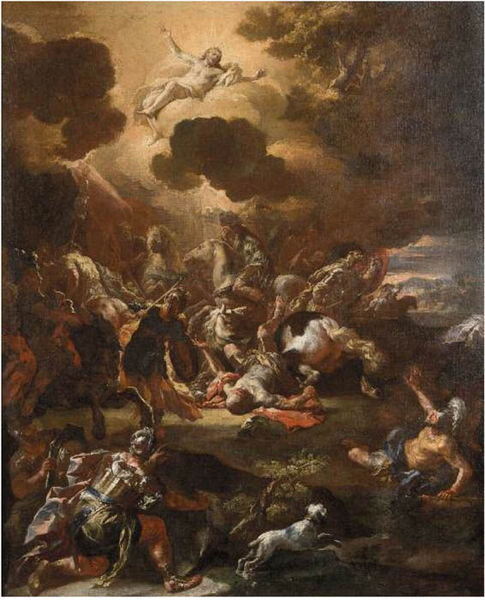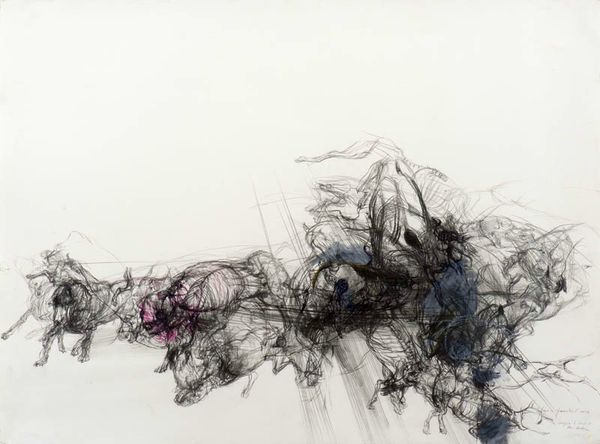"The Birth of Cinema…and Beyond" at rosenfeld porcini
Ferrau Fenzoni (1562-1645), Christ Nailed to the Cross, oil on canvas, 106 x 145 cm ©rosenfeld porcini
Cesare Lucchini, Those who remain - the fall 2013, oil on canvas, 180 x 243 cm ©rosenfeld porcini
LONDON - rosenfeld porcini presents The Birth of Cinema…and Beyond a themed exhibition presenting mixed-media work by old master and contemporary artists.
The exhibition will explore the way in which an idea of a virtual cinema existed in people’s imaginations before the invention of the medium itself. Old master and contemporary works will be juxtaposed in an attempt to explore how narrative approaches have altered with the change in societies and further reveal in a non-definitive way how cinema has been a creative stimulus for many artists’ practices. This will be the third in the gallery’s series of themed exhibitions and will bring together seven contemporary artists including AÌda Rubio Gonzalez, Gideon Kiefer, Cesare Lucchini, Robert Muntean, Miriam Vlaming, Lanfranco Quadrio and Fatma Bucak alongside ten Old Master painters; Dirck Hendricksz (called “Teodoro D`Errico”), Ferraù Fenzoni, Gregorio de Ferrari, Ubaldo Gandolfi, Antonio Joli, Giovanni Lanfranco, Andrea Micheli (called “Il Vicentino”), Domenica Piola, Johann Heinrich Schönfeld and Francesco Solimena.
When people entered a church in Catholic Europe and saw a painting recounting a Biblical episode, they could insert the scene into a virtual film which they carried in their heads. The same thing happened when viewing paintings that recounted the great stories of Greek mythology in private palaces. Either through aural or written story-telling, people used their individual interpretations created in their minds of the story in question, inserting the visual episode in front of them, into this imaginary piece of cinema. This process was a very active one as was the understanding of the painting and how it fitted into the story.
Such notions concerning a visual representation of a “cinematic” experience referred to the great subjects. Yet the invention of cinema in the 19th Century somewhat removed viewers individual, subjective storytelling and replaced it with an “objective” narrative which was provided by the film. In today’s more commercial cinema, viewers are no longer required to participate in any active way because an extraordinary amount of visual, sound and verbal information is already provided. The film might engage us emotionally but in many cases an active, intellectual response is not required.
The Birth of Cinema…and Beyond focuses on the presence and the influence of the cinematic narrative in specific works. Three moments from the Crucifixion (before, during and after) by three different old master artists are juxtaposed with an image by the Swiss painter Cesare Lucchini, where a large body lies dead, sprawled across the foreground of the painting. Alongside Lucchini’s work the gallery presents a large work by Andrea Micheli depicting the moment David slays Goliath. Beside this work is a further painting by Lucchini featuring a child soldier. Whereas David saves his people by conquering the seemingly unconquerable giant Goliath and Christ dies on the cross to redeem humanity for their sins, in Lucchini’s contemporary vision there is no such redemption.
In a further section ‘Escape from the burning Troy’ by 17th Century Italian painter Giovanni Lanfranco faces a large monochromatic drawing by the contemporary Italian artist Lanfranco Quadrio which depicts Acteon transforming into a stag while being devoured by his hounds. The scene reveals various different successive moments of the action; time being stretched in front of our eyes, within the context of a single drawing. This is a direct result of his exposure to film. Johann Heinrich Schönfeld’s ‘Rest After the Hunt’ illustrates a scene outside a ruined temple in a country landscape where various groups of people are involved in a variety of conversations and actions. The gallery tries to create a dialogue between this work and the vibrant urban characters which populate the paintings of the contemporary Spanish artist Aída Rubio González. Her world echoes through paint the freedom best expressed by Pedro Almodovar in his unique street scenes. Whereas the cinematic form depicts multiple narratives across endless images, these paintings reveal multiple narratives within a single work.
Works by Robert Muntean and Gideon Kiefer involve us in further reflections on the influence of cinema on contemporary artists, and in the final part of the exhibition, a work by 18th Century Italian painter Francesco Solimena depicting ‘The Conversation of St Paul’ – a scene rich in a spectacular cinematic narrative – is presented alongside Fatma Bucak’s video ‘Blessed Are Those who Come’. Her film is set against the remains of a church from c.1100 on the Turkish-Armenian border where a group of village elders stand in a loose semi circle and observe a woman dressed in black enacting a seemingly religious ritual. As they comment ambiguously on the action unfolding before them, numerous possible meanings unfold for the viewer. On a formal level, the film is shot almost totally from a fixed frame therefore actively looking back to the old masters use of multiple narratives within a single image. With this work the exhibition has come full circle as the endless possibilities which the discovery of cinema gave to the world of contemporary narrative have returned to the discipline imposed by a single image.
Cesare Lucchini, Child Soldier 2013, oil on canvas, 220 x 173cm ©rosenfeld porcini
Cesare Lucchini, Those who remain - the fall 2013, oil on canvas, 191 x 197 cm ©rosenfeld porcini
Cesare Lucchini, Child Soldier 2013, oil on canvas, 214 x 191 cm ©rosenfeld porcini
Robert Muntean, Everest, 2013, oil on canvas, 240 x 200 cm ©rosenfeld porcini
Robert Muntean, Your life was into my mouth, 2013, oil on canvas, 200 x 240 cm ©rosenfeld porcini
Robert Muntean, Returner 2013, oil on canvas, 180 x 300 cm ©rosenfeld porcini
Dirk Hendricksz called “Teodoro d’Errico”, The Crucifixion, oil on panel, 87 x 52 cm ©rosenfeld porcini
Miriam Vlaming, Little Shot 2013, oil on canvas, 60 x 40 cm ©rosenfeld porcini
Miriam Vlaming, Woman Insane 2013, oil on canvas, 100 x 140 cm ©rosenfeld porcini
Fatma Bucak, Blessed are you who come 2013, Video Still ©rosenfeld porcini
Francesco Solimena, Conversion of St Paul, oil on canvas 124 x 99 cm ©rosenfeld porcini
Lanfranco Quadrio, The Death of Actaeon 2013, work on paper, 148 x 200 cm
Lanfranco Quadrio, The Triumph of the Dogs 2007, charcoal, pencil on paper, 76x56cm
Lanfranco Quadrio, Body to Body 2007, charcoal, pencil on paper, 56 x 76 cm

/https%3A%2F%2Fprofilepics.canalblog.com%2Fprofilepics%2F1%2F0%2F100183.jpg)
/https%3A%2F%2Fstorage.canalblog.com%2F03%2F02%2F119589%2F96711876_o.jpg)
/https%3A%2F%2Fstorage.canalblog.com%2F11%2F31%2F119589%2F94773502_o.jpg)
/https%3A%2F%2Fstorage.canalblog.com%2F20%2F83%2F119589%2F94772815_o.jpg)
/https%3A%2F%2Fstorage.canalblog.com%2F26%2F72%2F119589%2F75604929_o.jpg)
/https%3A%2F%2Fstorage.canalblog.com%2F59%2F60%2F119589%2F26458628_o.jpg)


















/http%3A%2F%2Fstorage.canalblog.com%2F08%2F32%2F119589%2F112429114_o.jpg)
/http%3A%2F%2Fstorage.canalblog.com%2F81%2F80%2F119589%2F32536508_o.jpg)
/http%3A%2F%2Fstorage.canalblog.com%2F98%2F87%2F119589%2F121044900_o.jpg)
/http%3A%2F%2Fstorage.canalblog.com%2F00%2F20%2F119589%2F94643956_o.jpg)